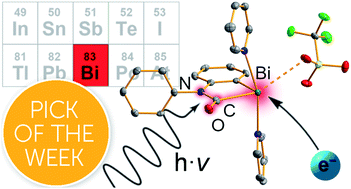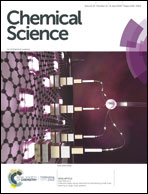Carbon monoxide insertion at a heavy p-block element: unprecedented formation of a cationic bismuth carbamoyl†
Abstract
Major advances in the chemistry of 5th and 6th row heavy p-block element compounds have recently uncovered intriguing reactivity patterns towards small molecules such as H2, CO2, and ethylene. However, well-defined, homogeneous insertion reactions with carbon monoxide, one of the benchmark substrates in this field, have not been reported to date. We demonstrate here, that a cationic bismuth amide undergoes facile insertion of CO into the Bi–N bond under mild conditions. This approach grants direct access to the first cationic bismuth carbamoyl species. Its characterization by NMR, IR, and UV/vis spectroscopy, elemental analysis, single-crystal X-ray analysis, cyclic voltammetry, and DFT calculations revealed intriguing properties, such as a reversible electron transfer at the bismuth center and an absorption feature at 353 nm ascribed to a transition involving σ- and π-type orbitals of the bismuth-carbamoyl functionality. A combined experimental and theoretical approach provided insight into the mechanism of CO insertion. The substrate scope could be extended to isonitriles.

- This article is part of the themed collections: 2019 Chemical Science HOT Article Collection and 2019 ChemSci Pick of the Week Collection


 Please wait while we load your content...
Please wait while we load your content...